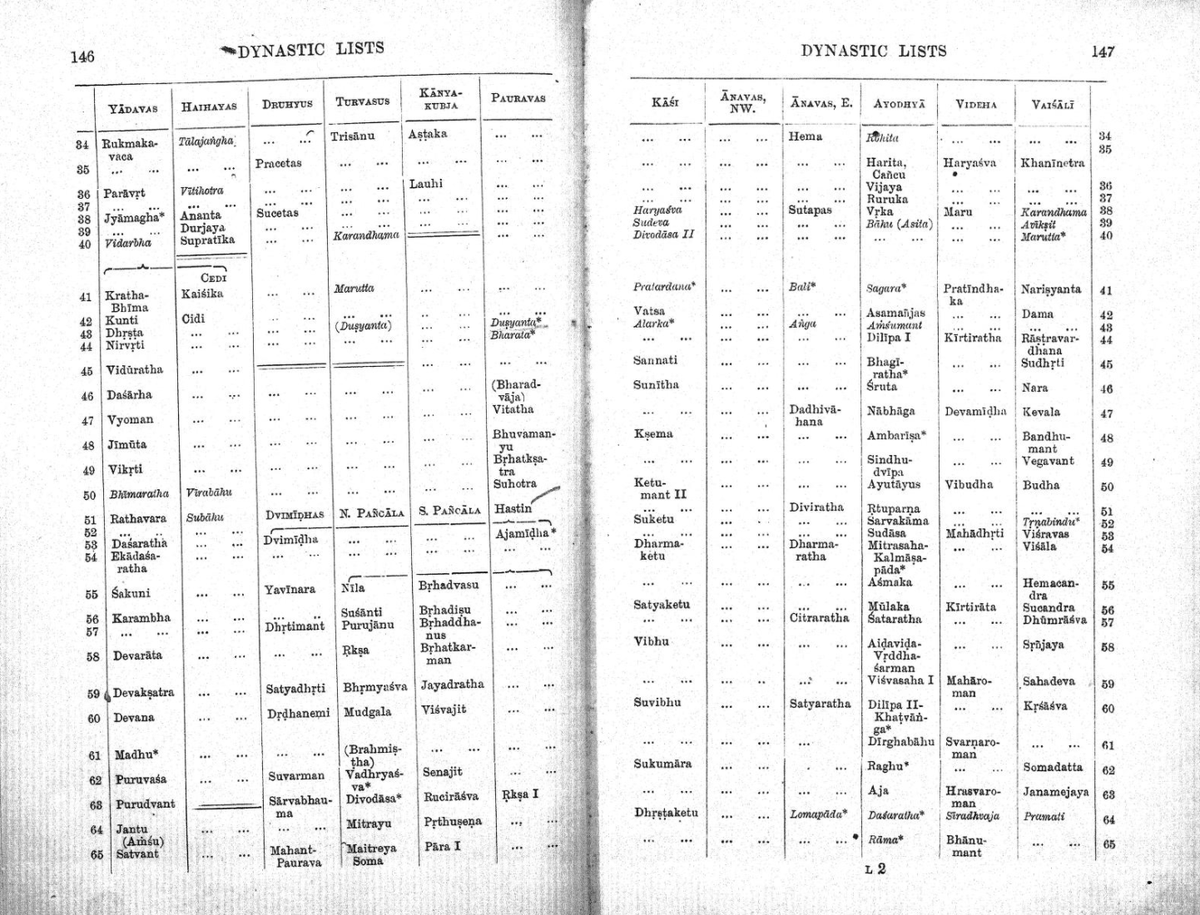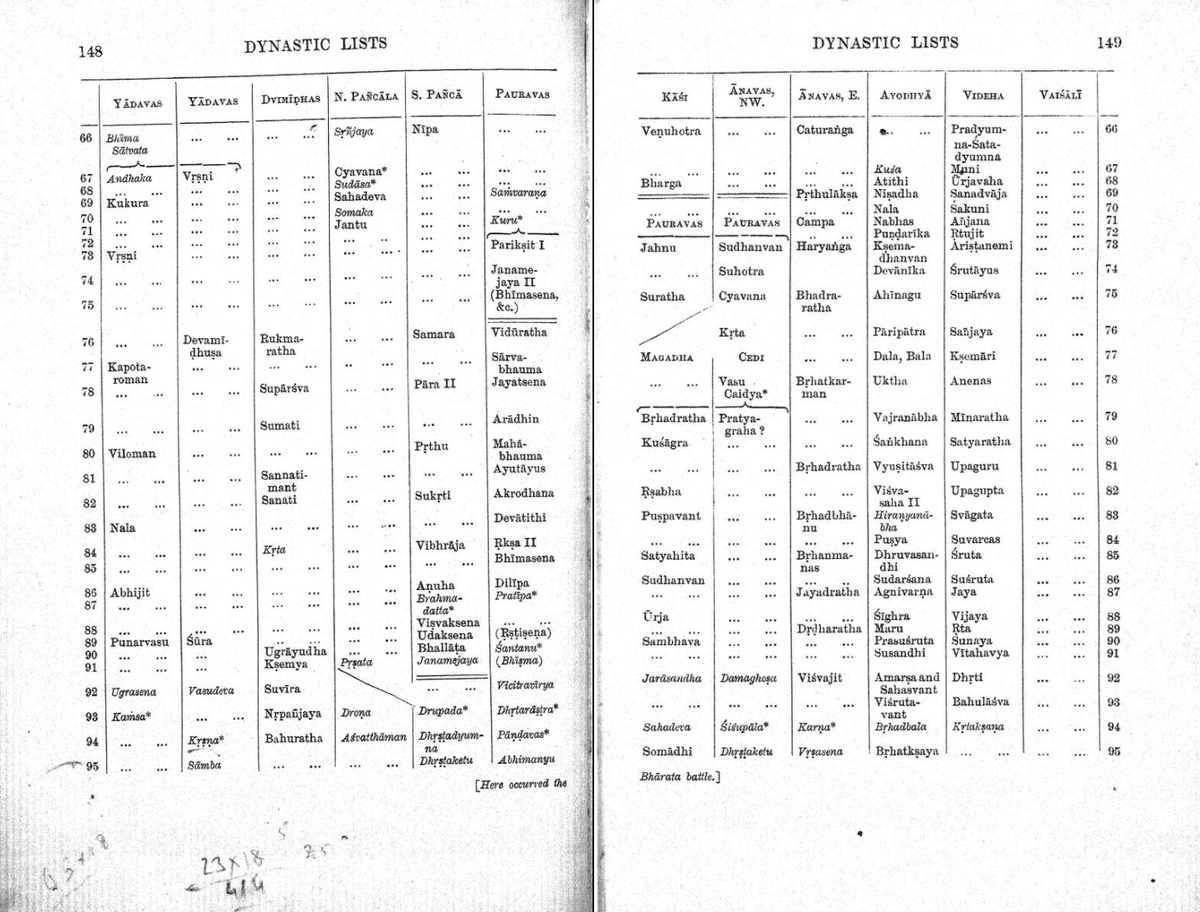This excellent dynastic list compiled diligently by FE Pargiter from Puranas sheds much light on early Indian chronology
Some takeaways
1. The IkshvAku king Shri Ramachandra precedes the Mahabharata heroes by 29 generations (albeit belonging to totally different dynastic lines)
Some takeaways
1. The IkshvAku king Shri Ramachandra precedes the Mahabharata heroes by 29 generations (albeit belonging to totally different dynastic lines)
2. Rama also precedes Sudasa, the hero of the Rig Vedic Dasarajna war by 3-4 generations
Even if I take a generous 20 years per king as the regnal period average -
You get roughly ~500-600 years between Shri Ramachandra and the Kurukshetra heroes
Even if I take a generous 20 years per king as the regnal period average -
You get roughly ~500-600 years between Shri Ramachandra and the Kurukshetra heroes
And roughly 400-500 years between Sudasa, the Rig Vedic protagonist, and his very distant cousins, the Kauravas of Mahabharata
Now Puranic testimony is also used to place the Mahabharata war circa 1400-1200 BCE (let& #39;s take the average - 1300BCE)
And that is also contemporaneous with sections of Yajurveda/Atharva veda
And that is also contemporaneous with sections of Yajurveda/Atharva veda
Using the earlier genealogical record shared, we can estimate at least some sections of Rig Veda (the ones dealing with the Dasarajna war) to be circa ~1600 BCE
With the glorious period of Ikshvakus preceding that slightly
With the glorious period of Ikshvakus preceding that slightly
One point to note is that the "synchronisms" established in that attachment - establishing the contempraneity of kings w.r.t. each other is the result of the work of FE Pargiter
Who was perhaps the earliest scholar to suggest Sudasa is contemporaneous with Samavaruna, the Puru
Who was perhaps the earliest scholar to suggest Sudasa is contemporaneous with Samavaruna, the Puru
This is discussed in greater detail in this fine blogpost by Ghora https://aryanthought.wordpress.com/2014/05/27/the-joy-of-discovering-synchronisms-part-1/">https://aryanthought.wordpress.com/2014/05/2...
PS : Got interested in this topic thanks to exchanges with @ArmchairPseph and @GhorAngirasa
Who may want to add more nuance in more threads on this topic
Who may want to add more nuance in more threads on this topic
Post-script 2 : Dating RV itself is dicier than dating the events described in it
The kings can be roughly placed using the help of genealogies
But the hymns in the Shruti may be recollecting ancient events and may not be contemporaneous with events
The kings can be roughly placed using the help of genealogies
But the hymns in the Shruti may be recollecting ancient events and may not be contemporaneous with events
So suppose Dasarajna war is circa 1600 BCE for the sake of argument.
It does not follow that the RV hymns discussing Sudasa also date to that period. They could be later compositions
It does not follow that the RV hymns discussing Sudasa also date to that period. They could be later compositions
My general thoughts on why the above exercise is important and fascinating -
Because it represents an attempt to understand Indian proto-history using our own tradition - the Shruti, itihAsas, and purANas
We are not relying here on conjectures by indologists
Because it represents an attempt to understand Indian proto-history using our own tradition - the Shruti, itihAsas, and purANas
We are not relying here on conjectures by indologists
And the funny thing is -
Even a cursory study of our own tradition is giving us dates that are not all that inconsistent with the timelines suggested by indologists
Even a cursory study of our own tradition is giving us dates that are not all that inconsistent with the timelines suggested by indologists

 Read on Twitter
Read on Twitter



